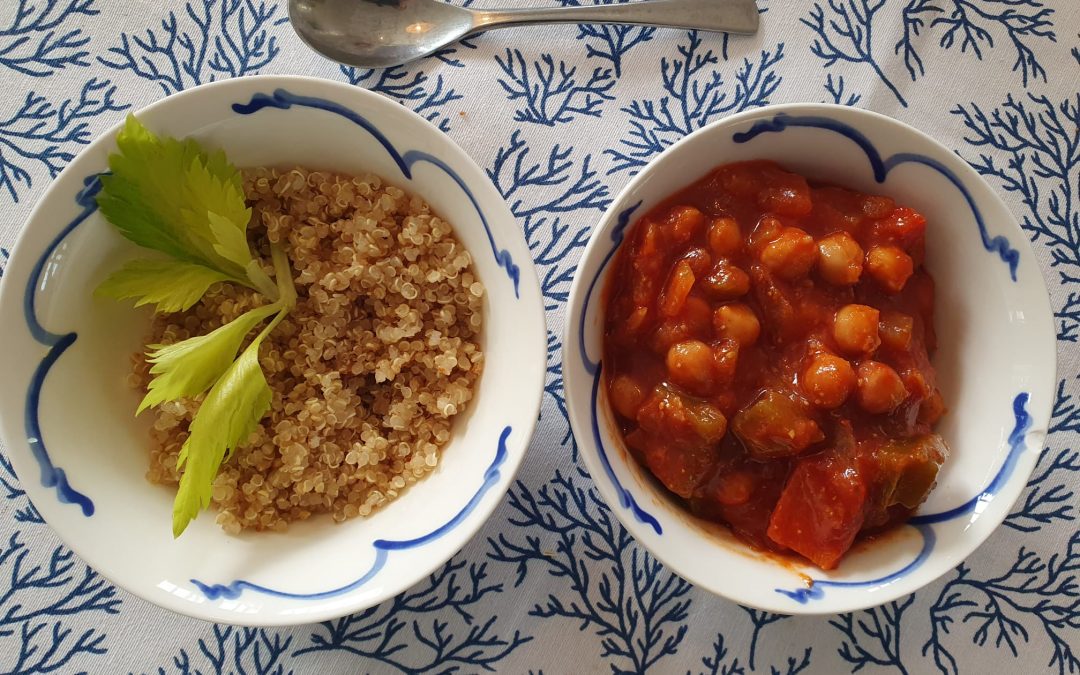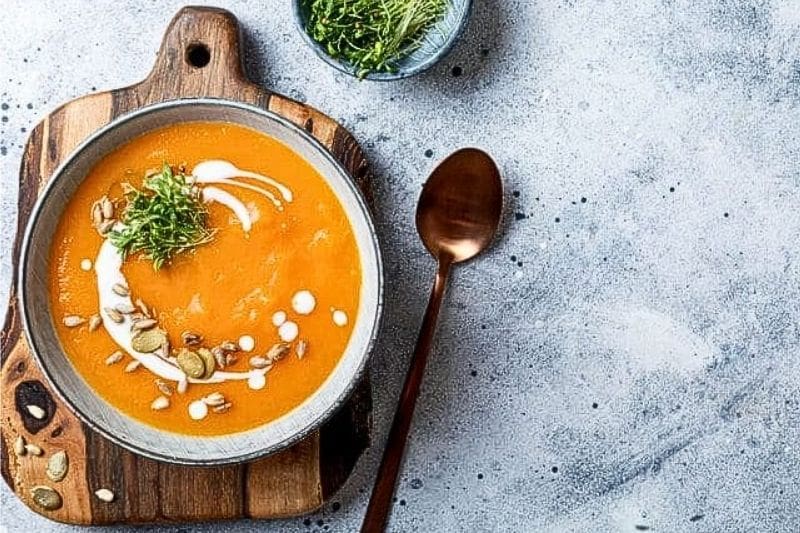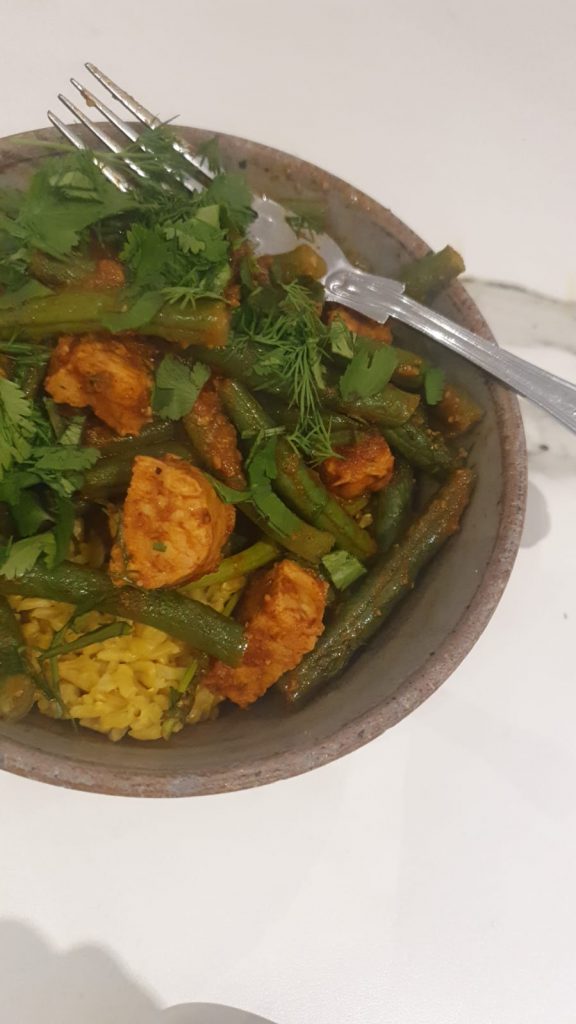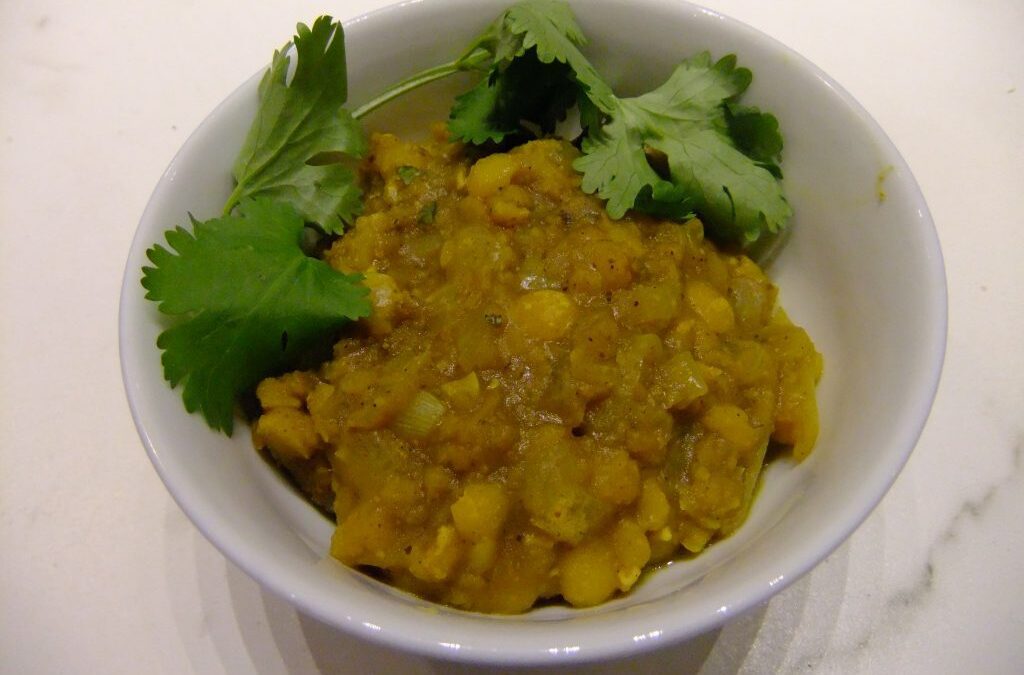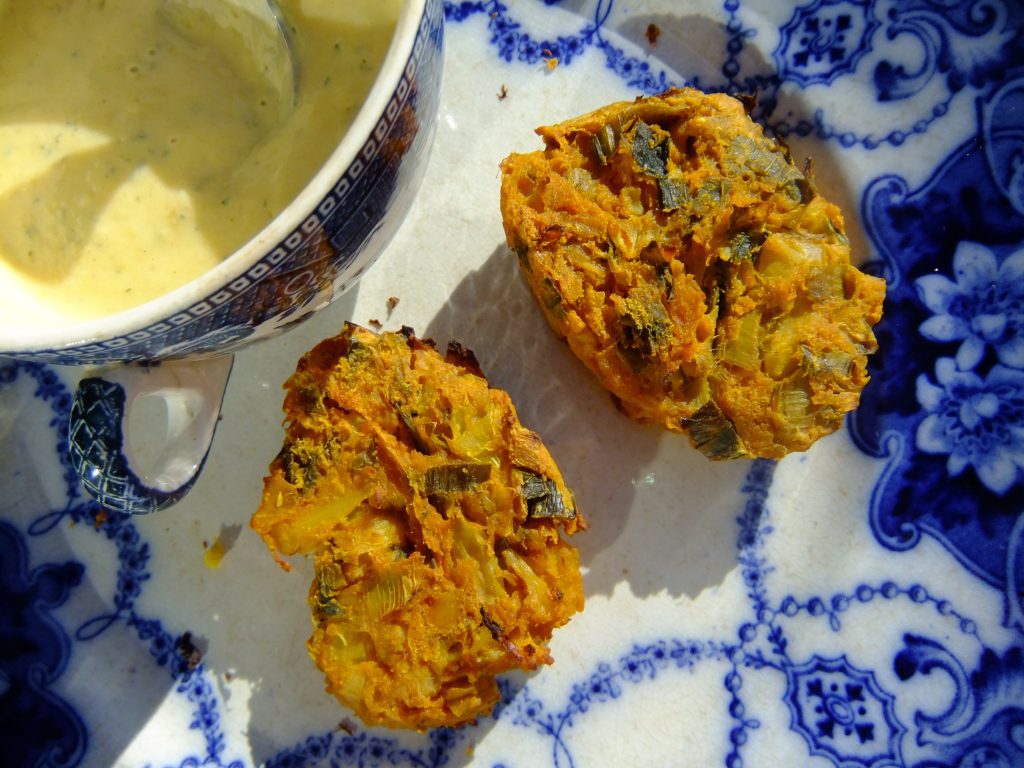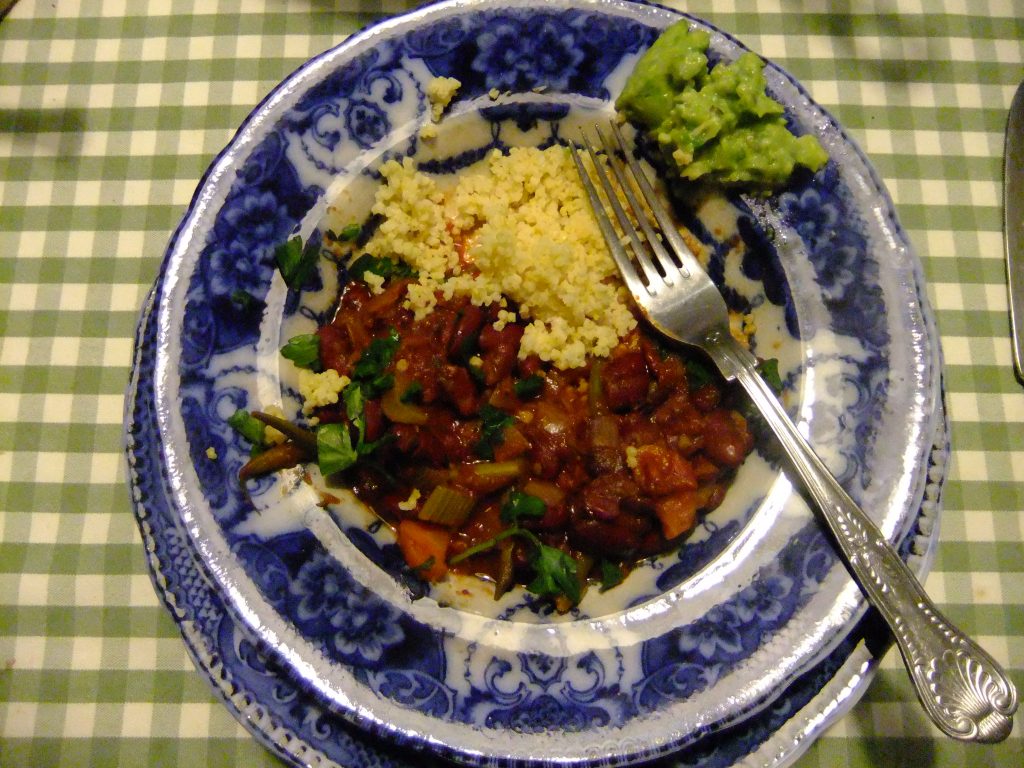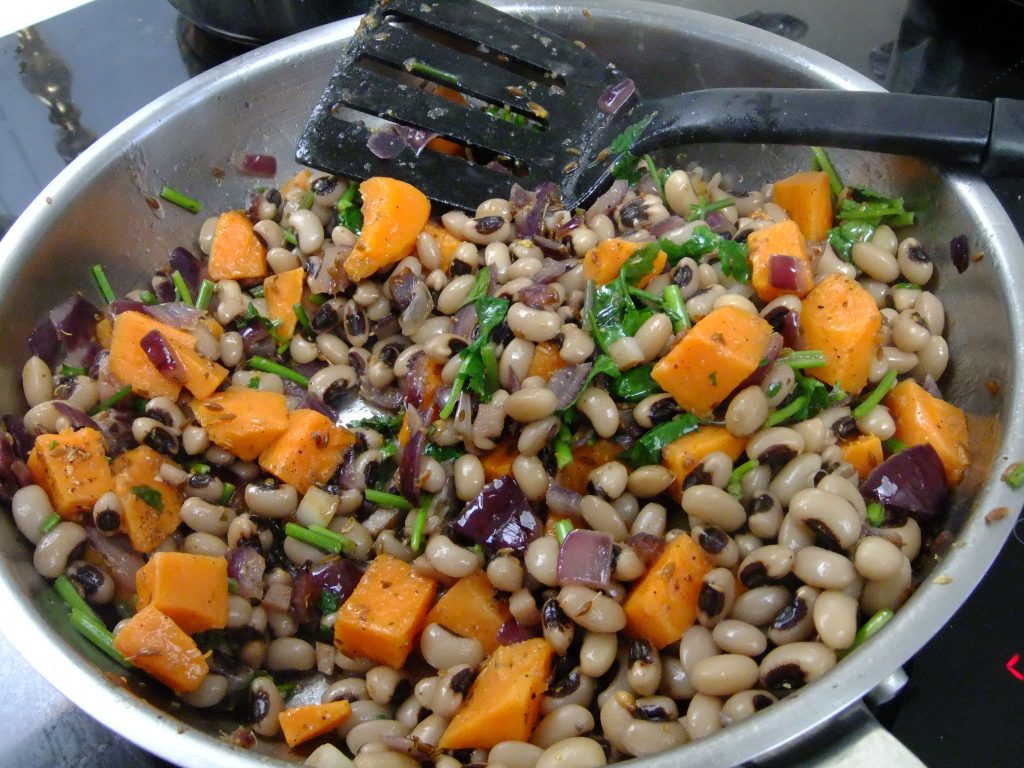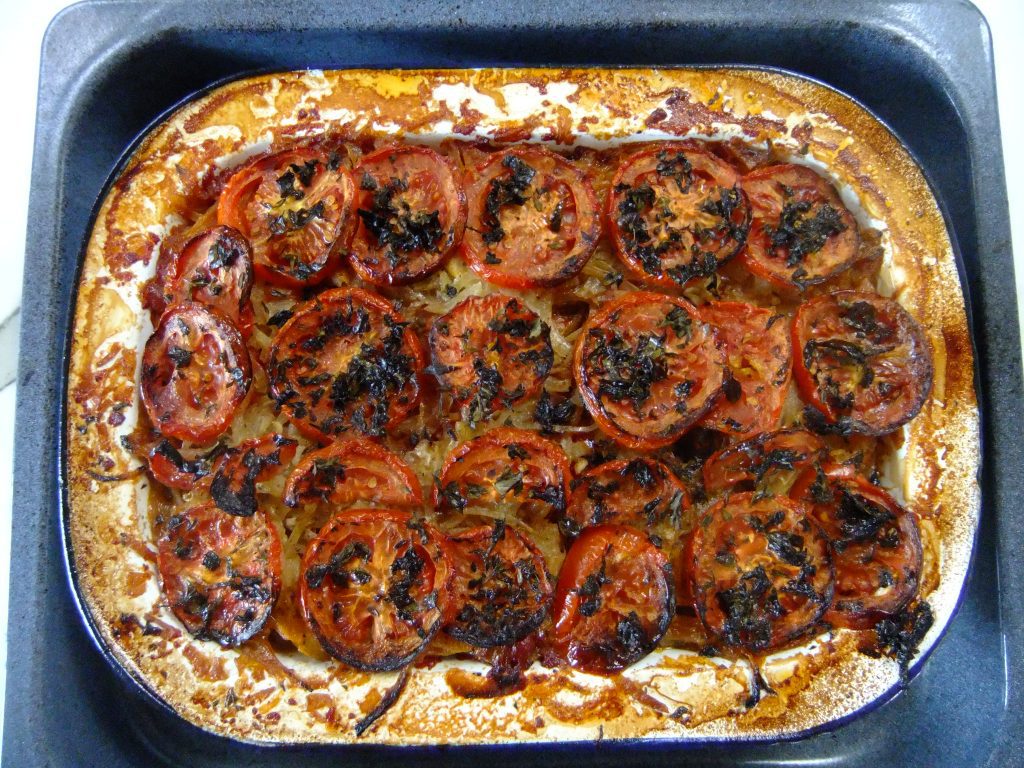
Nov 4, 2025 | Anna's Best Recipes
My mother used to cook this in the 1980s, long before vegan eating was a thing. I still love it and it’s so warming on a dark winters evening. It also works well with red kidney beans, white haricot beans or butter beans. I like to have this with quinoa for an extra protein kick but brown rice would also be OK.
For 4 (or 2 with freezer leftovers)
2 x 400g cans chickpeas (or 400g dried, soaked overnight then boiled hard till tender, reserving the cooking water)
2 medium onions, peeled and chopped fine
2 large green peppers (or 4 small), de-seeded and chopped fine
1 tbs extra virgin olive oil
1/2 tsp chili powder (optional)
Heaped teaspoon ground coriander
Heaped teaspoon ground cumin
Heaped teaspoon freshly grated ginger
4 tbs tomato puree
275ml boiling water or leftover veg-steaming water
lemon juice to taste
Sea salt/Himalayan salt and freshly ground black pepper
To serve:
Cooked quinoa (allow 1/4 cup of raw grains per person) or brown rice
Extra virgin olive oil
1. Heat a large heavy bottomed saucepan on a gentle heat, add oil, onions, green peppers, spices and 1 tbs of water. Cover with a lid and gently “steam-fry” until onions are translucent and softened but not brown. If everything begins to dry out, add another tbs of water.
2. While that’s happening, boil the kettle to cook your quinoa and put this on. If you’re not familiar with cooking quinoa, instructions are at https://annacollins.ie/how-to-cook-quinoa/
3. Dissolve the tomato puree in 275ml of reserved chickpea cooking water or boiling water. Add this, the chickpeas and some freshly ground black pepper to the vegetables and mix everything together.
4.Cook 10 minutes, add a little lemon juice, more black pepper and salt to taste.
5. Serve with the quinoa/brown rice and a drizzle of extra virgin olive oil
Why this is good for you:
There are a ton of reasons but I’ll just give you a few of them here.
Green vegetables are rich in magnesium, Nature’s tranquilizer and essential nutrient for detoxification, regular bowel, healthy blood sugar, and beautiful skin.
Chickpeas and onions are rich in prebiotic fibre to feed the healthy bacteria you need for every aspect of health – including healthy immunity, great gut health and a calm mind.
Herbs, spices and extra virgin olive oil are rich in polyphenols – plant antioxidants that are also super-intelligent “antibiotics”. Supporting friendly bacteria and lowering “bad” bugs that cause chronic ill-health.
Tomato puree is a powerful source of lycopene – this polyphenol (natural plant chemical) reduces inflammation, supports skin health, eyesight and keeps you youthful longer. Lycopene is more bio-available (usable by your body) when tomatoes are pureed/processed than when they are raw!
Protein rich – 1 cup cooked chickpeas gives you approximately 14.5-15g protein and 1 cup cooked quinoa 8g. That’s around 23g of protein. Most people, women especially, don’t eat enough protein. And that makes us more susceptable to stress, inflammation, infections and hormone imbalances (e.g. hypothyroid, PMS, problematic menopause…).
Raw extra virgin olive oil is a powerhouse of vitamin E which helps vitamin C to work for your immunity, your energy production and your infection control.

Sep 28, 2023 | Anna's Best Recipes, Main courses, Sides, starters, soups & snacks
Now Autumn’s here and with it some crazy storms I’ve rediscovered this high protein immune-supporting soup that’s a bowl full of sunshine. To make it into a complete meal add a cupful of cooked greens per person at the end (a bag of baby spinach would do). If you want to gain weight, add some extra carbs such as wholemeal gluten-free bread or leftover cooked rice (reheat well in the soup). If you eat gluten) some 100% rye or wholemeal sourdough. This soup freezes well too.
For 4
Note: You can save yourself effort chop all veg and spices only roughly if you’re going to blend the soup later on.
1 very large onion or 2 medium chopped onions
2 large sticks celery, sliced
2 large carrots (about 300g), sliced
2 heaped tbs (tablespoons) finely grated fresh ginger
1-2 rounded tbs ghee or virgin coconut oil (if you have an inflamed gut, ghee is best).
3 cloves garlic, crushed
Heaped teaspoon turmeric powder
Heaped teaspoon coriander powder
1/2 level tsp ground cardamom powder if you have it
500ml carton of passata (sieved tomatoes) or a 400g can chopped tomatoes
750ml filtered water or leftover vegetable cooking water (e.g. from steaming veg)
250g (mug and a quarter) dried red lentils
1 heaped tsp health store additive-free vegetable stock powder (for the SC Diet use Dr Coys Organic Vegetable Bouillon)
Freshly ground black pepper
1. Heat a large heavy-bottomed saucepan with lid on a medium heat for a minute. Add ghee/oil, onion, celery, carrots, ginger and a small splash of water, cover with a lid and sweat for 10 minutes.
2. Add garlic, turmeric and cardamom if you have it, stir for a minute before adding passata/tinned tomatoes and water.
3.Give everything a stir then add the lentils so they sit on top (otherwise during cooking they stick to the bottom). If the lentils are not entirely submerged in liquid, add a bit more water or stock.
4. Boil for 15-20 mins for 20 mins/until lentils and veg are soft. Only stir the lentils gently at the very top if they are stuck together, otherwise leave them alone.
5. Mix the veg stock powder into a little water and add to the soup AFTER the the lentils are soft (otherwise salt makes the lentils touch).
4. If you want a smooth soup now give it a whizz with a stick blender.
5 reasons this is good for you:
Lentils and onions contain prebiotic fibre. This feeds friendly bacteria you need for healthy digestive system and immunity.
Turmeric, ginger, garlic, coconut oil, cardamom and coriander reduce numbers of disease-causing bacteria/viruses in your gut.
Processed cooked tomatoes are the richest source of antioxidant lycopene to help ALL of you
Ghee contains butyric acid, a metabolite produced by friendly bowel bacteria to keep your gut and immune system tip-top.
Lentils are a rich and easy-to-digest source of protein which is essential for antibody production to protect against infection.

Jan 30, 2022 | Anna's Best Recipes, Main courses
This is my current favourite way to use tofu or tempeh. I adapted it from Ottolenghi’s more complex recipe. My husband is a tofu-hater so when he disappears for a few days I always cook this. Keep in mind that unfermented soya products contain digestion-blocking proteins that damage your gut. So DO make sure to buy the fermented forms for this dish: tempeh or fermented tofu (it will say on the pack).
If you don’t have a small-bowl food processor, chop the chili finely, crush the garlic and use a pestle and mortar to bash the caraway seeds about as much as you can before mixing with the other spices and oil.
For 2
This is gorgeous served with cauliflower/broccoli “rice”, konjac noodles or brown basmati rice.
350g trimmed French (or use runner beans cut in 6cm bits)
Salt and black pepper
200g non-GMO tempeh or fermented tofu, cut into bite size cubes
A few sprigs of dill (small handful), destalked and roughly chopped
Small handful fresh coriander, destalked and roughly chopped
For the sauce:
4 garlic cloves, peeled and crushed
1 green or red chili, deseeded (optional)
2 slightly rounded tsp sweet paprika
1 tbs caraway seeds
1.5 tsp ground cumin
½ level tsp ground Ceylon cinnamon
2 tbs + a little extra avocado oil or extra virgin olive oil
3 tbs tomato puree
250ml water or leftover vegetable-steaming water (full of nutrients!)
Optional: 1 heaped tsp honey or non-toxic sweetener e.g. Dr Coy’s Stevia Erylite or xylitol (from good health stores)
2 limes
Black pepper
Himalayan or sea salt
- For the sauce put the garlic, spices, chili and 2 tbs oil in the small bowl of the food processer and blitz to a thick paste. You might need a touch more oil to bring it together.
- Heat a pan on a medium heat and add a teaspoon more of avocado/olive oil and stir fry the garlic-spice mix for 30 seconds.
- Then add the tomato puree, 250ml water and bring to the boil.
- Stir in the honey or non-toxic sweetener, lime juice, generous pinch (1/4 a level tsp) salt and a few good grinds of black pepper.
- Add the tempeh, turn down the heat, cover and simmer while you prep the green veg.
- Steam the French/runner beans for around 2-3 minutes until the colour changes very slightly and they are softened but still have a bit of crunch.
- Finally, just before serving, stir the herbs into the tofu and sauce, pile on top of your rice and enjoy.
Serve with:
Low carb: Cauliflower or broccoli rice https://www.annacollins.ie/cauliflower-rice/ or konjac noodles from Asian stores.
Medium carb: brown basmati rice cooked with a generous pinch of turmeric
Why this is good for you:
Spices are a powerhouse of antioxidants that help rebalance your gut bacteria in favour of the good guys. The good guys helps digest your food, repair and maintain your gut lining every minute of every day, and reduce inflammation in you. This has massive implications for your immune system, your gut health and even your mood. Yes, anxiety/depression states always involve brain inflammation. Type the name of just one spice into medline (the scientific journal resource) and you’ll find hundreds of peer-reviewed scientific studies.

Jan 14, 2022 | Anna's Best Recipes, Main courses
This is DELICIOUS, and simple and fast at 15 mins cook time. Had it for dinner last week and SO enjoyed its warming aromatic spices. I swapped out the refined cooking oil in the original recipe by Chetna Makan for healthier virgin coconut oil which doesn’t mess with your metabolism. If you don’t like coconut oil you could also use avocado oil or at a push light olive oil. The first 2 oils are healthier.
You’ll find tinned no-added-sugar black eyed beans in health stores and Asian shops.
Serves 4 (I like to make this quantity to have some yummy leftovers for the freezer)
2 tbs virgin coconut oil
2 large onions, peeled and finely chopped
2 big garlic cloves, peeled and grated or crushed
2½cm piece fresh root ginger, peeled and grated
400g tin chopped tomatoes
½ level tsp salt
¼-½ level tsp chilli powder or the milder cayenne (if you don’t like heat, leave out)
1 tsp garam masala
1 tsp ground turmeric
300g chestnut mushrooms, thinly sliced (white button mushrooms will do)
400ml tin full -fat coconut milk (organic brands, especially if you have any digestive issues at all)
2 x 400g tins black-eyed beans, drained and rinsed (or make your own – soak overnight 200g black eyed beans and boil hard until tender).
1.Heat the oil in a pan, add the onions, 2 tbs oil and a tablespoon of water. Cover with a plate or lid (or tinfoil) and cook on medium heat until softened, translucent and no longer crunchy.
2.Add the garlic and ginger, cook for a minute, then pour in the tomatoes and cook on a low to medium heat for five minutes.
3.Stir in the salt and ground spices, followed by all the remaining ingredients, stir well and bring to a boil.
4.Cover, then leave to cook on a medium heat for 15 minutes. (If you have more time, cook it over over a lower heat for 30-40 minutes.).
Serve warm with:
SC Diet: squash wedges sprinkled with curry powder and roasted in the oven + 2 cups steamed greens per person – nice ones are broccoli, runner/green beans or cabbage/spring greens.
Medium carb: ½ cup cooked brown basmati rice (avoid for SC diet) + 2 cups steamed greens per person – nice ones are broccoli, runner/green beans or cabbage/spring greens.
Low carb (SC diet-friendly): broccoli rice or cauliflower rice (available frozen in supermarkets). Super simple how to cook instructions at https://www.annacollins.ie/cauliflower-rice/
Why this is good for you:
Beans are a good source of protein while spices are powerful anti-inflammatories. Spices modify your gut bacteria in favour of the good, useful ones that control every (and I mean every) aspect of your health. Spices are more antioxidant gram for gram than any fruit or vegetable. Small quantities pack a powerful punch. Did you know that 1g turmeric twice a day is shown to reduce acid reflux (heartburn). Herbs and spices now have thousands (or maybe tens of thousands) of scientific studies confirming their actions on the human body. Whats not to like? A more interesting range of flavours in your meals AND massive benefits to your present and future health – digestive, mental, immune and so much more…

Feb 23, 2018 | Anna's Best Recipes, Main courses
This is gorgeous. The tomatoes and apples perfectly balance the earthy flavour of yellow split peas. Like all beans and pulses this is more digestible and cooks faster if you soak the split peas overnight in clean cold water to about twice their depth in a saucepan or bowl. This is even better the next day and freezes really well.For 2 people with 1 serving of leftovers
160g/1 mug dried yellow split peas
1/2 level tsp ground turmeric to add to the cooking water
1 tbs ghee or virgin coconut oil
1 heaped tsp cumin seeds
1 medium onion, finely chopped
1 gently rounded tsp garam masala (available in Asian stores)
1/2 level tsp ground red chilli
1/2 level tsp ground turmeric
400g chopped tomatoes, ideally fresh but canned will do
160g cooking apples, peeled, cored and chopped into 1cm piecesGarnish:
2 tbs chopped fresh coriander1. If using dried split peas: Place the peas with 800ml clean water and the 1/2 tsp turmeric in a heavy-based saucepan and bring to the boil over a medium heat. Skim off any foam. Reduce heat to medium, cover and cook for 25 minutes until tender.
If using soaked split peas: discard the soak water, place the peas and the half teaspoon turmeric in a saucepan with enough clean water to cover by about 2cm. Boil for a few minutes, skimming off any foam before turning down the heat to medium, cover and cook till tender for between 15 and 20 minutes. SOAKED SPLIT PEAS ARE BETTER IF YOU HAVE A SENSITIVE GUT.
2.
Meanwhile heat the ghee or coconut oil in a heavy-based pan on a medium heat, add 1 dsp water along with the onions and cover with a lid. Sweat, stirring occasionally, until the onions are translucent. If its drying out too much before the onions are done, add a little more water to keep it steam-frying rather than browning or burning.
3. Stir in the rounded tsp of garam masala, 1/2 tsp of chilli and 1/2 tsp turmeric. Cook for a minutes, stirring and then add the tomatoes and the apple.
4. cook for about 25 minutes until most of the liquid has been absorbed, the apples are soft and the tomatoes have broken down.
5. Add the cooked split peas and simmer for a few minutes.
6. Garnish with the chopped coriander.Serve with:
Steamed greens (e.g. broccoli, green/runner beans, cabbage, sprouts, pak choi) plus one of the following:
Cauliflower rice
https://www.annacollins.ie/cauliflower-rice/
Indian spiced squash
https://www.annacollins.ie/?s=indian+spiced+squash
Not for SC diet: Brown rice or quinoa
Why this is good for you
This has a range of fibres that feed different categories of good gut bacteria, all of which you need to remain well. Pectin from the cooking apples, inulin from the onions, soluble fibre from the split peas all feed good bacteria. Cumin and garam masala have a suppressing effect on “bad”, pro-inflammatory bacteria in your gut. I always recommend a wide variety of plant types and herbs and spices to people who want to optimise their health and get digestive, bowel or autoimmune issues into remission. And guess what – stewed cooking apple in this recipe helps lower bowel inflammation too.

Feb 17, 2017 | Anna's Best Recipes, Sides, starters, soups & snacks

Gluten-free baked cauliflower bahjis
I’ve been craving bhajis that are not deep-fried and finally got my wish with this lovely oven-baked recipe. This recipe is slightly adapted from one by Susanna Booth in the Guardian. Great for a buffet, finger food for a party, as a starter, or cold for a picnic. Everyone’s happy to eat it and take seconds. They
don’t need to know that its both gluten-and dairy-free! I like these just as much cold as hot.
NB some mango chutneys contain malt vinegar, which contains gluten, so read the label carefully before you buy.
Makes 15-20
For the bhajis
300g cauliflower
2 medium leeks, green and white parts
1 tbs olive oil (or, even better, virgin coconut oil)
100 gram (chickpea) flour
1 rounded tsp (teaspoon) ground turmeric
1 level tsp ground coriander
1 level tsp ground cumin
A pinch of Himalayan or Atlantic Sea Salt
80ml water
2 tsp mango chutney (make sure it’s a gluten-free one that does not contain malt vinegar) OR 2 rounded tsp St Dalfour or Follain no added sugar apricot jam and a pinch of ground ginger OR 2 tsp unsweetened mango puree (you can do this by blitzing the mango for the dip and reserving 2 tsp for the actual bahjis).
2 rounded tsp tomato puree
Olive oil (or even better, virgin coconut oil) for greasing the baking tin
For the dip
100g natural soya yoghurt (or natural yoghurt or thickened kefir for for milk-eaters)
Half a ripe mango
1 rounded tbs (tablespoon) mango chutney (again, make sure it’s gluten-free)
5 fresh large mint leaves
1. Preheat the oven to 180C. Wash and prepare the cauliflower and leeks. Dice the cauli into tiny pieces; cut the leeks lengthways and then into thin slices. Sweat all the veg in the olive oil in a heavy bottomed pan, covered with a lid, for 5-10 minutes until just softened.
2. Put the gram flour, spices and salt in a bowl. Add the water, chutney and tomato puree and mix to a smooth paste. Add the sweated vegetables and stir until everything is well coated. It will be very thick.
3. Drizzle a little olive oil over a taking tray. Rub with a spatula or brush to coat the whole surface.
4. Dollop the bhaji mix on the tray 1 tbsp at t time. Flatten them a little with the back of a spoon, spatula or fishslice.
5. Bake for 10-15 minutes until slightly browned. Take the tray from the oven, then flip each bhaji over using a fish slice. Bake for another 10-15 minutes until golden. You can eat them hot or cold.
6. Make the dip by blitzing the chutney, mango, mint and yoghurt together in a mini food processor or else use a bowl and stick blender. Refrigerate for up to a day before serving.
Variation:
I made an imitation mango chutney for this recipe by mixing a few things I had in the cupboard: 1 1/2 tbs St. Dalfour apricot jam, a pinch of onion salt, a large pinch of each of dried garlic and ground coriander and 1/2 teaspoon of distilled or wine vinegar.
Why this is better for you:
Gram (chickpea) flour is a good source of protein to help keep you feeling fuller for longer. Leeks are rich in inulin, which helps feed good gut bacteria. Good bacteria are important for all aspects of your health from weight management to clear skin and good digestion and absorption of nutrients. Because these bhajis are baked rather than deep fried which means they don’t toxic heated polyunsaturated oils. In cooking, coconut oil is even better for you then olive oil. This is because coconut oil is less damaged by heating then olive oil. coconut oil is rich in medium chain triglycerides, which can help boost energy because the body digests them very easily. Amazingly, coconut oil is used by your body directly to make energy rather then being stored as fat in your body. This makes it a better tool for weight management than many other oils. Herbs and spices such as turmeric, cumin and coriander have well-documented anti-inflammatory properties and a great health boost for anyone who cares about their health, fitness or skin.

Dec 14, 2016 | Anna's Best Recipes, Main courses

This is a lovely, warming dhal, the earthiness balanced by the lemon juice (my other yellow split pea dhal recipe uses tomato and apple to lift it). Make a double portion and freeze half for another dinner. I’m eating more of this sort of meal in the run-up to the great Christmas splurge in a couple of weeks.
Make a double quantity and store leftovers in the freezer for another time.
For 2:
100g (about half a large mug) dried yellow split peas
1.5 cm fresh ginger, grated on the fine side of your grater
1 onion, peeled and chopped
1 dsp coconut oil
1 level tsp cumin, ground
½ tsp turmeric
1 clove garlic, crushed or chopped
2 bay leaves
1 level tsp mixed spice
Juice of ½ lemon
Freshly ground black pepper
1. Cook the split peas in 3 times their volume of water along with the ginger, until tender (do not allow to dry out completely). This takes around 15 minutes.
2. Meanwhile, sweat the onion in a covered pan with the oil and 1 dessertspoon of water, when the onions are translucent, add all the spices, bay leaves and garlic and stir for a minute.
3. Add the split pea mixture (you may need to drain off some water) and cook until the split peas are beginning to crumble.
4. Add lemon juice and black pepper to taste
Serve with:
4 large handfuls of steamed vegetables eg. sliced kale, green beans, Brussels sprouts, wilted spinach and, if you like, some starchy carbs like roasted squash wedges, celeriac or turnip. If you are NOT on the SC diet, some brown rice is another option.
Why this is good for you
Garlic and spices are profoundly anti-inflammatory. This is partly because they help reduce numbers of disease-causing bacteria in your intestine while also promoting growth of helpful species. But spices also contain polyphenolic substances. These stimulate your body to increase antioxidant activity to keep you in peak condition and delay the ageing process. Split peas, garlic and onions contain soluble fibre which feeds beneficial bacteria. The peas are also rich in magnesium needed for great stress management, good sleep and beautiful skin (amongst other things).

Nov 10, 2016 | Anna's Best Recipes, Main courses
I love to eat this when the weather gets cold and we want comfort food in the evening. This was a family favourite cooked by my mother for many years. Kids seem to like it though you might need to omit hot chilli and cayenne and use paprika instead. Make a large batch and store leftovers in the freezer for future ready-meals.
If you don’t like kidney beans then borlotti, cannellini or butterbeans will work just as well.
For 4:
225g (1 large mug) dried red kidney beans (or 2 tins sugar free kidney beans, drained and rinsed)
1250ml water for boiling (if using dried beans)
1-2 dsp extra virgin olive oil
225g/1 very large onion, finely or roughly chopped
2 large cloves garlic, crushed
450g mixed veg, chopped (eg. red/green peppers, carrot, celery, turnip, runner beans, green beans, courgettes)
Heaped tsp dried basil
Rounded tsp ground cumin
½ tsp cayenne pepper
½ tsp chilli powder (optional – avoid if you don’t like hot spices)
400-500g passata (sieved tomatoes) OR a 400g can tomatoes, liquidized/mashed
2 tbsp tomato puree
3 tbsp red wine (optional)
Stock (liquid reserved from cooking the beans) or water
Juice of ½ lemon (optional)
Freshly ground black pepper and Himalayan or Atlantic sea salt
1. If using dried beans: Soak the beans overnight in filtered water, drain and rinse well. Bring to the boil in fresh water and boil fast for at least 10 mins so any protease-inhibitors are destroyed (you can give yourself an awful cramp and tummy upset if you don’t do this when cooking beans). Then cover the pot and simmer for a further 35-40 mins or until the beans are soft – cooking time varies. If you find the water tends to boil over, it helps to add a teaspoon of olive oil. When the beans are soft, drain and reserve the stock for use later.
2. Put the onion and garlic in a large heavy bottomed saucepan with 1 tbs olive oil and 1 tbs of water, cover with a lid and sweat for a few minutes until translucent. Then add the chopped vegetables, beans (if using tinned, do not add till later), basil and spices. Stir well, then cover and sweat (on low heat) 5 mins
3. Next add tomatoes/passata, tomato puree, red wine and 1/4 pint of the stock/water.
4. Bring the mixture to the boil, cover and simmer for 20 mins until the veg are softened.
5. Add the lemon juice and seasonings, tinned beans (rinse well first)or cooked beans. Increase the stock level if you like your casseroles fairly liquid then cook for a further 10-15 mins until the vegetables are tender.
Serve with:
- A green salad or steamed broccoli.
- Some cooked quinoa, millet or brown rice is nice with this (but avoid all of those if you are on the SC diet!). The quinoa in particular, with its 11% protein, will keep you fuller longer. If you are on the SC diet, just put a few more carrots and turnip or celeriac in the casserole for extra carbs.
- My one minute guacamole: mash a ripe avocado or two with a pinch of Himalayan or Atlantic sea salt. Add fresh lime juice to taste (one lime is usually enough for two small avocados) and if you like, a pinch of chilli or a chopped red chilli.
Why this is good for you:
Taking a break from meat and having vegetable protein instead provides food for your good gut bacteria. Maybe that is part of the reason why a semi-vegetarian diet helps people live longer. Herbs and spices all have medicinal qualities as they encourage antioxidant activity in our body – good news for reducing inflammation, helping your skin and your intestines. They also help suppress disease-causing bacteria in your gut while encouraging the growth of helpful species.

Sep 12, 2016 | Anna's Best Recipes, Main courses, Packed lunches, Sides, starters, soups & snacks

Bleck-eyed beans with sweet potato and coriander
This is real comfort food and a great crossover dish for feeding vegetarians and carnivores at the same dinner table. It’s pretty rich in protein do if you are feeding a vegetarian its a good choice. But you can also serve it as an accompaniment to roast or grilled meat or fish. I love to eat it as a vegetarian dinner with just a simple green salad or some steamed green/runner beans drizzled with olive oil and paprika. The recipe was I think from Cafe Paradiso but I changed the recipe a bit to use non-toxic oils. Hope you enjoy it. It also works great as a salad in a box to take to work or school.
For 6 as an accompaniment or 3 as a main course
2 medium-sized sweet potatoes, peeled
1 large bunch coriander, stalks and all, chopped
400g dried black-eyed beans (health stores/most supermarkets) soaked in boiling water for 45 minutes
or
2 cans of tinned black eyed beans, drained and rinsed
2 tbs extra virgin oive oil (1 dsp for cooking and 3 dsp for mixing in at the end)
2 large red onions, peeled and sliced or chopped
1½ heaped tsp cumin seeds (the Asia Market good for inexpensive spices)
3 large cloves garlic, peeled and finely chopped
1½ tbs lime juice
¼ tsp Himalayan salt or Atlantic sea salt
1. If using dried beans (and not tinned) , drain the soaked beans and put them into a large pot, adding enough boiling water to cover the beans by a few centimetres, and bring to the boil. Skim off any foam that comes to the surface and cook on a gentle boil for at least 45 mins. Top up with more hot water if it reduces too much. Test the beans to see if they’re cooked and continue until they’re done, when they should be drained, reserving the stock. If using tinned beans, rinse and drain well.
2. Dice the sweet potatoes into ½”/1 cm cubes. Then steam until the point of a knife goes in easily but they are not mushy. Drain carefully and keep the liquid.
3. Place 1 dsp olive oil and 1 dsp water in a large heavy bottomed saucepan, add the onion and cumin and sweat (covered) on a medium heat, stirring occasionally, until the onions are translucent. Add the garlic and cook for another 2 mins. Add the lime juice, bring to the boil, then remove from the heat. Gently mix in the sweet potato, beans, the rest of the olive oil (1½ tbs), coriander, ¼ teaspoon salt, plenty of freshly ground black pepper and ideally leave sit for an hour before serving. This intensifies the flavours.
Why this is good for you:
Extra virgin olive oil, is good for heart health. It contains anti-inflammatory vitamin E, polyphenols and a whole host of other compounds shown to boost our health and vitality. Coriander helps sooth your digestive system and also helps reduce numbers of “bad” bacteria in your digestive system. Too many unhelpful types of bacteria in your gut can cause acne, digestive disorders and even anxiety states and low mood.
Beans are a rich source of magnesium, deficiency of which is linked to stress, constipation, insomnia, anxiety and difficulties with skin health. Refined foods (sugar/white grains), alcohol, stimulants and smoking rob you of magnesium.

Aug 31, 2016 | Anna's Best Recipes, Main courses, Sides, starters, soups & snacks
This is delicious hot, lukewarm or cold. I also like to mix leftovers with cooked quinoa to take to work. People living on the Greek island of Ikaria have the secret of healthy longevity. This is one of their recipes, which I found in the Irish Times recently. We can’t get giant white beans here but butter beans work really well. I wasn’t sure it would turn out well, but it was delicious – very intense flavours. It contains a lot of liquid. So make sure to use a large dish, otherwise it can boil over in the oven (like it did on me). Slicing the carrots very thinly is a bit of a fiddly chore unless you use a mandolin or a food processor. If you can’t face it or don’t own a decent knife: slice about 1/2 cm thick, steam for a few minutes to soften (keeping the water to make the veg stock with so you don’t lose flavour or nutrients). If you put thick sliced raw carrots into the dish they will still be raw when everything else is starting to burn! Yummy though. This also works well as a side dish with, say, roast lamb.
For 4:
6 tbsp extra virgin olive oil
1 x 640g jar of passata (sieved tomatoes)
2 x 400g tins butter beans, drained (or soak 400g or 2 cups dried beans overnight and boil till tender)
3 onions, finely sliced
4 garlic cloves, finely sliced
4 carrots, thinly sliced
2 large beef (or 4 regular) tomatoes, sliced
A good handful of fresh oregano (if you can’t get it, use 1 dsp dried)
A few sprigs of thyme
2 bay leaves
300ml vegetable stock
Sea salt and ground black pepper
- Preheat an oven to 220 degrees (205C fan).
- Add the onions and garlic to a bowl with four tablespoons of olive oil. Season with sea salt and ground black pepper. Massage the onions until they begin to soften down.
- Arrange the butter beans in the base of a large earthenware or baking dish. Place carrots on top.
- Pour over the passata and spread evenly. Arrange the onion mixture across the top, then the tomato slices and press the herbs on top.
- Pour over the vegetable stock, drizzle on the remaining oil and season. Bake on the middle shelf for 40 minutes or until the point of a knife or cooking skewer goes through the carrots easily.
Serve warm, lukewarm or cool with a green salad on the side. You can use leftovers as an accompaniment to grilled or baked white fish. Or (provided you’re not on SC Diet) stir into cooked quinoa to make a quick lunch (or packed lunch).
Why this is good for you:
Butter beans, onions and garlic give you soluble fibre which feeds good gut bacteria needed to help you get rid of toxins, have happier mood (yes, gut bacteria make the feel-good brain chemical serotonin!) and a healthier immune system. A healthy immune system is one that doesn’t over react causing autoimmunity (e.g. rheumatoid arthritis, hypothyroidism). Nor does it under react causing lowered resistence to viral, bacterial or fungal infections. Lycopene in tomatoes is fantastic for supporting vision and so are carrots with their various carotenoids. Lycopene and carotenoids are antioxidants – they protect you from damage.
